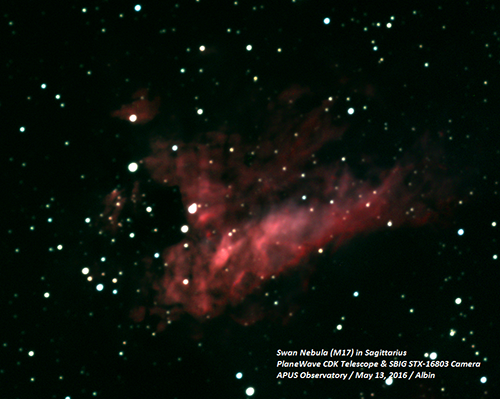A passion for sharing the universe with our students.
When Space Studies Program Director Dr. Ed Albin came home from school as a child, the family television was tuned to news about the Apollo program and astronauts walking on the Moon. Dr. Albin remembers, “I had a neighbor who had a telescope who would show me the Moon and stars. We learned the constellations. I've always been fascinated with telescopes and using instruments to photograph and collect data from the night sky.”
Today, Dr. Albin collects data from the night sky in a way he could never have dreamed and shares his passion for astronomy as the Director of Space Studies at AMU. “The Space Studies program prides itself on its highly credentialed faculty and its diverse student population. We have many faculty members who work for NASA, and our students range from young people right out of high school to graduate students who are NASA engineers. What sets our program apart is the excellence of our faculty, students, and this wonderful facility we have,” said Dr. Albin.
The university’s technology center in Charles Town, WV, houses a 650-pound telescope with a mirror that is two feet across. The instrument is not designed for climbing up a ladder and looking through the telescope. Instead, a highly sophisticated digital camera allows the telescope to acquire images of the Moon, stars, and planets. Students can log in and have hands-on experience with a state-of-the-art optical instrument. “This will help our students with their resume when they go out and look for jobs,” said Dr. Albin. “We are one of a few online universities with a Space Studies program that operate such a large telescope. It's going to give our students a very nice edge when it comes to graduation and actually going out into the career field.”
Not all brick-and-mortar schools with astronomy concentrations have telescopes. “The big difference is that telescopes are usually only accessible by traveling to the university's observatory to look through the instrument,” states Dr. Albin. “At AMU, we have students from all over the United States and in several countries across the globe. As long as they have Internet access, they can link to the telescope and work with our faculty to learn how the telescope works, use the cameras, and acquire images that can be downloaded to their computers. We're not just going to websites and pulling down images. We're actually collecting our own data that students can base their research on.”
According to Dr. Albin, very few space studies degrees match the breadth and scope of the AMU innovative online program, which attracts individuals from a variety of professions related to NASA, the U.S. intelligence community, government agencies, general education, science, and military sectors. The curriculum was originally designed by former NASA astronaut Dr. James Reilly, veteran of three shuttle missions and five spacewalks.
Dr. Albin says, “We are very proud of our faculty. Many of our faculty work for NASA, and also have done quite a bit of astronomical research. One of our faculty members is an astronomer at Apache Point Observatory in New Mexico.
“I have personally worked in the field of astronomy for about 30 years. I think in today's world, having taught both in the brick‑and‑mortar university and also online, I'm finding as the technology gets better and better, especially with our telescope, there's no need to be up in an observatory or at a remote mountain top in order to acquire data.”

Dr. Albin controls the telescope from his computer.

Images produced by the telescope.

More Featured Faculty

Dr. Jose Rodriguez

